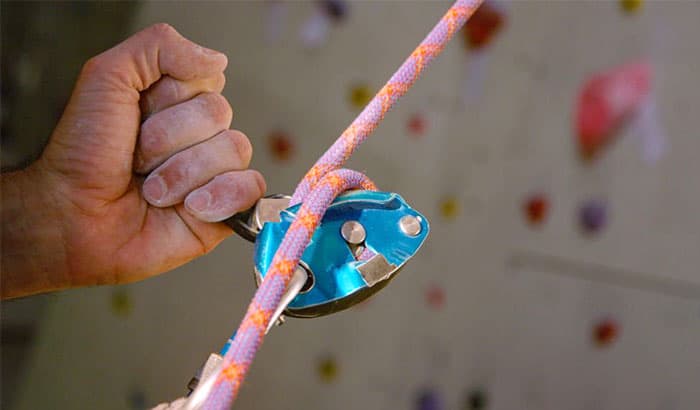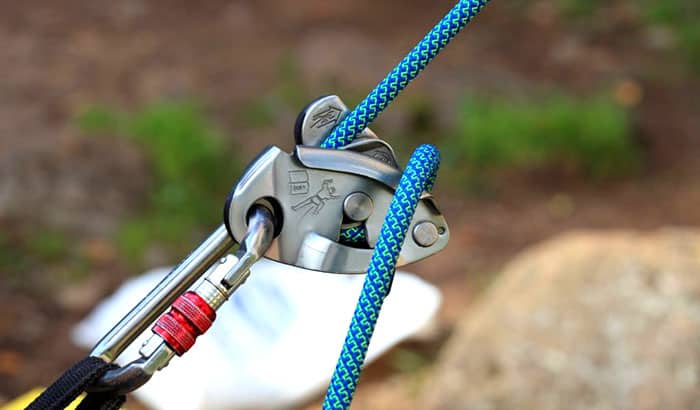GriGri is a popular belaying device manufactured by Petzl. Its popular feature is a clutch that assists in braking under a shock load. But do you know that this auto-locking belay device can also get you down a route? This article provides this information as we try to learn how to rappel with a GriGri properly.
Step 1: Understanding How GriGri Works when Rappelling
Grigris is designed for belaying, but it is different from other belaying devices because it comes with an assisted braking mechanism. This braking mechanism is composed of a friction plate and a cam that will lock once the clutch is close to breaking a fall through a shock load.
This belaying device will let the rope pass through when a climber moves slowly. But once the rope is moving fast, the braking mechanism will automatically rotate and pinch the rope to stop the climber or make him slow down.
This braking mechanism also allows the climber to work in one place or just hang on the rope once they have tied a backup knot. These features enable climbers to rappel and do other things because of the GriGri’s multiple uses.
But you must remember that GriGri is intended for belaying, which means it can be tricky to use it on rappelling. But it can be done; just make sure to learn and practice first to enhance your safety before doing it in an actual outdoor setting.
Step 2: Step-by-Step Guide in Rappelling with a GriGri
- The initial step is to set up your rappel in a regular manner by running the rope through the anchor setup. During the setup process, you must make sure that both ends of the rope are touching the ground.
- Then, you will need to block one of the ropes so that it will become fixed. All you have to do is pull up and tie an overhand knot so that it can block in the ring. The size of the knot must be big enough for it to stop the rope from pulling through to the anchor.
- Then, you can add the GriGri to the other line to rappel. You can also back it up by using a locking carabiner and putting it on the loop on the other line while locking it down. If you want more security, you can choose to put it through and lock it on the other line so that it cannot pull through.
- It is essential that you should be knowledgeable already and know what you are doing before your rappel down. You are expected to have already practiced rappelling down using this device to give you confidence once you are in the actual situation.
- Before going down, make sure that everything is working fine for your safety. You will also need to make sure that you are on the correct side of the rope. Make sure to always clip the rappelling device on the rope.
- Please be reminded to consistently apply your weight to the rope while ensuring that the knot is secured at the top. Once everything is checked and secured, then you can now proceed to rappel down.
- During the descent, you will need to slowly lift up the clutch through the use of your left hand as you start going down. Your right hand should be appropriately positioned on the rope to serve as your brake hand.
- If there is an instance that you want to stop, use the clutch to let it go. If you’re going to do other things other than quick adjustments, you can use a stopper knot on the break side of the GriGri.
Step 3: Knowing the Upsides and Downside of Rappelling with a GriGri
Using a GriGri to rappel will give you various advantages and disadvantages. One advantage is the braking mechanism which will let the climber automatically stop once he unintentionally does something wrong. This feature will make it safer for all beginners who are just starting to learn how to use this belaying device properly.
This braking mechanism will also help you get back up the rope if you need to. The latch feature of the GriGri will let the climber adjust the amount of friction on the system. This feature will be reliable once a climber decides to do technical rappels.
On the other hand, a GriGri can’t rappel on two strands coming out of the anchor. A climber can only rappel using a single strand by blocking at the rappel ring using a knot that will be attached to a locking carabiner.
Using a GriGri also limits its adaptability as it only works on a specific size of ropes. If the rope is too thick, you will not be able to rappel using the GriGri. Using a GriGri when rappelling also makes it harder to control the speed of your descent.
Conclusion
Learning how to rappel with a GriGri can be a fun experience because a lot of climbers have used it due to its auto-locking mechanism. However, it is a must for you to be familiar and knowledgeable before actually using it in an actual setup. There are advantages and disadvantages in using this belaying device to rappel but make sure to be safe all the time before actually doing it, especially outdoors.


